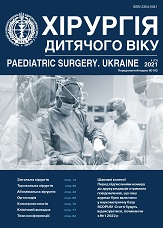Comparative characteristics of pilonidal sinus surgical treatment methods in children
DOI:
https://doi.org/10.15574/PS.2021.73.72Keywords:
pilonidal cyst, skin-fascial plastics, childrenAbstract
Pilonidal sinus (PS) is a common pathology of the coccygeal area, which occurs with a frequency of 26 per 100000 people. Operative methods of treatment of PS are accompanied by a high frequency of complications and recurrences. Finding ways to treat PS in children, which will help to reduce frequency of complications and the duration of postoperative wound healing remains relevant.
Purpose – to make a comparative analysis of the pilonidal sinus treatment methods in children: skin-fascial plastics, suturing to the bottom of the wound and suturing the wound tightly.
Materials and methods. An analysis of 90 cases of PS in children operated at the City Children’s Clinical Hospital was provided. Methods of skin and fascial plastics in our own modification, sinus removal with sewing to the fascia and primer closure were compared. The duration of surgery, time of postoperative wounds healing, intensity of pain in the postoperative period, duration of hospitalization and the frequency of complications were analyzed.
Results. The rate of pain intensity was on 60% lower on the first day and on 70% on the second and third days in cases of using skin-fascial plastics in comparison with the methods of sewing to the fascia and primer closure. Healing time was the shortest in cases of using skin-fascial plastics. The frequency of postoperative complications was by three times lower in operations with the method of skin-fascial plastics in comparison to other methods.
Conclusions. Skin-fascial plastics method reduces the intensity of pain more than 60% in comparison to other methods and reduces wound healing time more than 26% and 65% in comparison of the groups of sewing to the fascia and primer closure, respectively. The technique of removing of PS with skinfascial plastics in children usage reduces the number of complications by three times.
The research was carried out in accordance with the principles of the Helsinki declaration. The study protocol was approved by the Local ethics committee of all participating institution. The informed consent of the patient was obtained for conducting the studies.
No conflict of interest was declared by the authors.
References
Farrell D, Murphy S. (2011). Negative pressure wound therapy for recurrent pilonidal disease: a review of the literature. J Wound Ostomy Continence Nurs. 38: 373-378. https://doi.org/10.1097/WON.0b013e31821e5117; PMid:21606863
Iesalnieks I, Ommer A, Petersen S et al. (2016). German national guideline on the management of pilonidal disease. Langenbecks Arch. Surg. 401 (5): 599-609. https://doi.org/10.1007/s00423-016-1463-7; PMid:27311698
Duman K, Gırgın M, Harlak A. (2017). Prevalence of sacrococcygeal pilonidal disease in Turkey. Asian Journal of Surgery. 40: 434-437. https://doi.org/10.1016/j.asjsur.2016.04.001; PMid:27188235
McCallum IJ, King PM, Bruce J. (2008). Healing by primary closure versus open healing after surgery for pilonidal sinus: systematic review and meta-analysis. BMJ. 336: 868-871. https://doi.org/10.1136/bmj.39517.808160.BE; PMid:18390914 PMCid:PMC2323096
Meneiro P, Mori L, Gasloli G. (2014). Endoscopic pilonidal sinus treatment (E. P. Si.T.). Techniques in Coloproctology. 18 (4): 389-392. https://doi.org/10.1007/s10151-013-1016-9; PMid:23681300
Hussain F, Bramham B, Parveen S, Chakaravarty B. (2018). Pilonidal sinus: Surgical outcome of lay open versus primary closure technique. Journal of Dental and Medical Sciences. 17 (2): 1-7.
Pini Prato A, Mazzola C, Mattioli G et al. (2018). Preliminary report on endoscopic pilonidal sinus treatment in children: results of a multicentric series. Pediatric Surgery International. 34 (6): 687-692. https://doi.org/10.1007/s00383-018-4262-0; PMid:29675752
Yuksel ME. (2017). Pilonidal sinus disease can be treated with crystallized phenol using a simple three-step technique. Acta Dermatovenerol APA. 26 (1): 15-17. https://doi.org/10.15570/actaapa.2017.4; PMid:28352930
Gecim IE, Goktug UU, Celasin H. (2017, Apr). Endoscopic pilonidal sinus treatment combined with crystalized phenol application may preven trecurrence. Dis Colon Rectum. 60 (4): 405-407. https://doi.org/10.1097/DCR.0000000000000778; PMid:28267008
Downloads
Published
Issue
Section
License
The policy of the Journal “PAEDIATRIC SURGERY. UKRAINE” is compatible with the vast majority of funders' of open access and self-archiving policies. The journal provides immediate open access route being convinced that everyone – not only scientists - can benefit from research results, and publishes articles exclusively under open access distribution, with a Creative Commons Attribution-Noncommercial 4.0 international license(СС BY-NC).
Authors transfer the copyright to the Journal “PAEDIATRIC SURGERY.UKRAINE” when the manuscript is accepted for publication. Authors declare that this manuscript has not been published nor is under simultaneous consideration for publication elsewhere. After publication, the articles become freely available on-line to the public.
Readers have the right to use, distribute, and reproduce articles in any medium, provided the articles and the journal are properly cited.
The use of published materials for commercial purposes is strongly prohibited.

